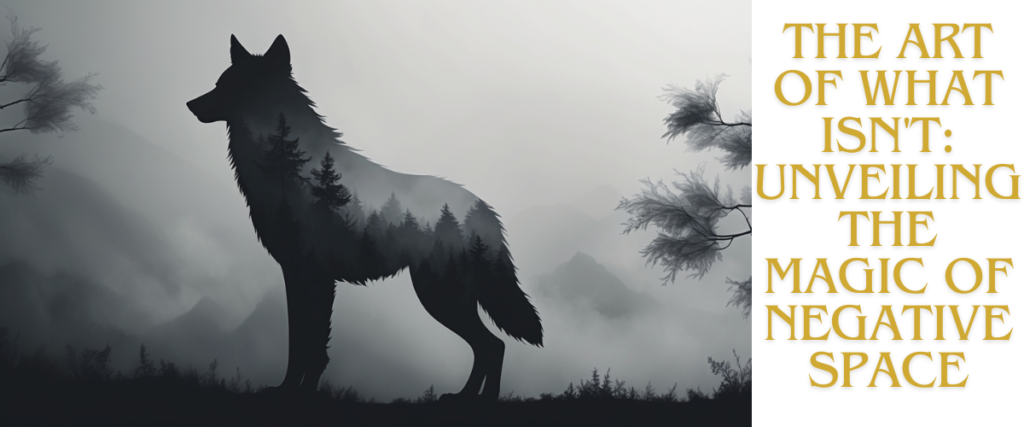We frequently concentrate on the tangible, sketched, sculpted, and positive space in the visual arts. However, what about the gaps between them? The blank spaces, the holes, the blank canvas? These are the unsung heroes of negative space art, a potent creative medium. It’s a technique that changes the way how we see things, bringing depth and beauty to the absence of shape.
Understanding the Fundamentals
The empty space between and around an image’s subject is essentially known as negative space. The background, the atmosphere, and the emptiness make up the “something.” Although it may seem paradoxical, artists deftly work with this void to produce songs that captivate audiences.
Consider a traditional silhouette. The figure, a solid black object, represents the positive space. However, what makes the figure visible to us is the bright background that surrounds it or the negative space. The silhouette would become an indistinct glob without it.
The Power of Perception
The human brain’s capacity to recognise shapes and complete patterns—even when they aren’t explicitly drawn—is the foundation of negative space art. Gestalt principles, a psychological phenomenon, are crucial to our understanding of great works of art.
- Figure-Ground Relationship: We naturally distinguish between a figure (the subject) and the ground (the background). Negative space art exploits this by making the ground as significant as the figure.
- Closure: Our thoughts have a tendency to fill in the blanks to form whole shapes. Negative space can hint at forms, enabling our brains to finish the image.
- Symmetry and Balance: Negative space can create visual balance and symmetry, even in asymmetrical compositions.
Techniques and Applications
Artists employ various techniques to harness the power of negative space:
- Silhouette: As mentioned earlier, silhouettes are a prime example. The stark contrast between the solid figure and the surrounding space creates a dramatic visual impact.
- Cut-Outs and Stencils: Cutting shapes out of paper or using stencils allows artists to define forms by their absence. This technique is often used in graphic design and street art.
- Drawing and Painting: Artists can carefully plan their compositions to emphasise the negative space, using it to frame and define the subject. They can also use shading and texture to create depth and dimension within the negative space itself.
- Sculpture: Sculptors manipulate negative space to create voids interacting with the surrounding environment. These voices can define the form of the sculpture and create a sense of lightness and openness.
- Photography: Photographers utilise negative space to create dramatic compositions, isolating subjects and emphasising their form. It is achieved by using a shallow depth of field or by photographing against a plain background.
- Typography and Logo Design: Negative space is crucial in creating impactful logos and typography. It can be used to create hidden messages or to define the shape of letters and symbols. The FedEx logo, with its hidden arrow, is a classic example.
The Emotional Impact
A variety of feelings can be evoked by negative space art, ranging from a sense of mystery and intrigue to a sense of calm and minimalism. In addition to highlighting the subject’s beauty and complexity, the emptiness can evoke a feeling of loneliness.
- Minimalism: The simplicity of negative space can create a sense of calm and clarity.
- Mystery: Hidden shapes and ambiguous forms can pique our curiosity and invite interpretation.
- Drama: The stark contrast between positive and negative space can create a sense of drama and intensity.
- Emphasis: Negative space can draw attention to the subject, making it stand out from its surroundings.
Examples Throughout Art History
Negative space has been employed throughout art history, from contemporary digital art to ancient cave paintings.
- Ancient Egyptian Art: Hieroglyphics and tomb paintings often utilised negative space to create clear and concise representations of figures and symbols.
- Japanese Ink Wash Painting (Sumi-e): This traditional art form emphasises the beauty of emptiness, using brushstrokes to create forms that emerge from the void.
- M.C. Escher’s Impossible Structures: Escher masterfully manipulated negative space to create optical illusions and paradoxical compositions.
- Modern Graphic Design: Contemporary graphic designers use negative space to create clean, minimalist logos and impactful visual communication.
Creating Your Own Negative Space Art
If you’re interested in exploring negative space art, here are a few tips:
- Start Simple: Begin with simple shapes and silhouettes.
- Experiment with Contrast: Use high contrast to emphasise the difference between positive and negative space.
- Think About the Background: Don’t neglect the background. It’s just as important as the subject.
- Look for Hidden Shapes: Pay attention to the spaces between objects. You might discover hidden forms.
- Use Stencils or Cut-Outs: This is a great way to experiment with negative space.
- Take Photographs: Experiment with different angles and lighting to capture interesting negative space compositions.
- Practice Observation: Actively look at the negative space within a daily object. Train your eye to see the space that surrounds every object.
Conclusion
More than merely an aesthetic decision, negative space art is a potent tool that enables artists to shape vision, arouse feelings, and produce captivating compositions. We can appreciate the intricacy and beauty of the invisible, the unsaid, and the empty by comprehending the concepts of negative space. It serves as a reminder that sometimes, the most important aspects of a piece of art are the ones that are present. Artists can produce works that have depth and significance through deft manipulation of the space surrounding a shape. It pushes us to perceive the world differently and to go beyond the obvious, realising that sometimes the lack of something may be just as potent as its presence.
Disclaimer
This blog only contains content that is meant to be informative and educational. Individual artistic interpretation and results may differ even when negative space art techniques and applications are explained. This blog does not represent expert artistic guidance. Personal investigation and experimentation are welcomed. The given examples are meant to serve as examples only and are not meant to be a comprehensive list of all negative space art artists or approaches.


